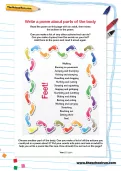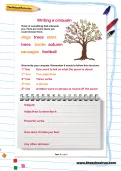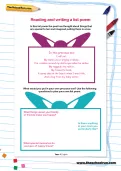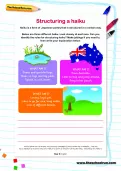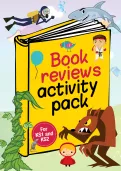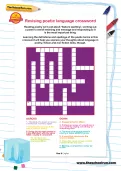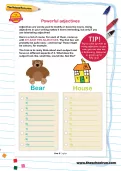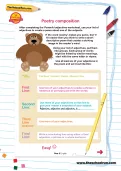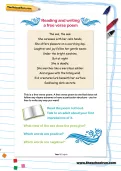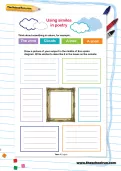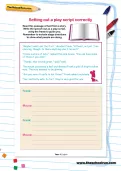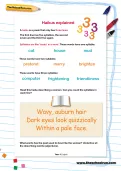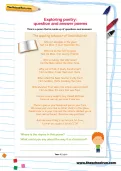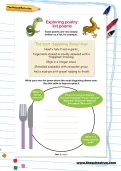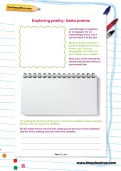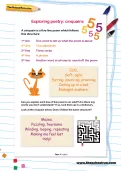Help your child explore books and language with TheSchoolRun's Book reviews activity pack, a huge collection of reading comprehension and creative writing resources for Year 1 to Year 6.
or
Register to add to your saved resources
Already a subscriber? to view this content.
Reading poetry isn’t just about ‘feature spotting’; working out a poem’s overall meaning and message and responding to it is the most important thing. Learning the definitions and spellings of the poetic terms in this crossword will help you express your thoughts about language in poetry, fiction and non-fiction texts, though.
or
Register to add to your saved resources
Already a subscriber? to view this content.
Adjectives are words use to modify or describe nouns. Using adjectives in your writing makes it more interesting, but only if you use interesting adjectives! Here is a list of nouns. For each of them, come up with AT LEAST TEN ADJECTIVES. The first few will probably be quite easy – and boring! These might be colours, for example. The trick is to really think about each subject and focus on different aspects of it. What does the subject look like, smell like, sound like, feel like?
or
Register to add to your saved resources
Already a subscriber? to view this content.
If the word ‘poetry’ makes you panic, don’t! It’s easier than you think to write a short descriptive poem that creates a striking image in the reader’s mind. Why not have a go?
or
Register to add to your saved resources
Already a subscriber? to view this content.
After reading this Robert Louis Stevenson poem, answer the questions.
or
Register to add to your saved resources
Already a subscriber? to view this content.
Challenge your KS2 child to a Shakespearean wordsearch. Can they find the titles of 14 of the Bard's famous plays hidden in the wordsearch grid?
or
Register to add to your saved resources
Read through this poem. In this poem, night is personified. Can you underline any phrases that suggest that night is a person? Then write down some of your ideas and use them to write your own poem that personifies night.
or
Register to add to your saved resources
Already a subscriber? to view this content.
Personification is a figure of speech in which a non-living object is given the characteristics of a person. Can you read through this poem and underline any examples of personification then have a go at writing your own personification poem?
or
Register to add to your saved resources
Already a subscriber? to view this content.
Each object in this poem is personified by a powerful verb and an adverb. Can you underline all the verbs in blue and all the adverbs in pink? Then draw four of the personified objects behaving as they are described.
or
Register to add to your saved resources
Already a subscriber? to view this content.
A free verse poem is one that does not follow any rhyme scheme or have a particular structure – you’re free to write any way you want! Read this poem out loud then talk to an adult about your first impressions of it.
or
Register to add to your saved resources
Think of something that interests you and write a cinquain about it. Remember to follow the correct structure.
or
Register to add to your saved resources
Think about something in nature. Now draw a picture of your subject in the middle of this spider diagram. Write similes to describe it in the boxes on the outside
or
Register to add to your saved resources
Already a subscriber? to view this content.
Read this passage of text from a story. Write the speech out as a play script, using the frame to guide you. Remember to include stage directions to show what people are doing.
or
Register to add to your saved resources
Already a subscriber? to view this content.
In this list poem the poet has thought about things that are special to her and imagined putting them in a box. What would you put in your own precious box? Use the following questions to plan your own list poem.
or
Register to add to your saved resources
A haiku is a poem that only has three lines. The first line has five syllables, the second seven and the third five again. Read this haiku describing a woman. Can you count the syllables in each line? What words has the poet used to describe the woman? Underline all the describing words (adjectives).
or
Register to add to your saved resources
Already a subscriber? to view this content.
Here is a poem that is made up of questions and answers. Where is the rhyme in this poem? What could you say about the way it is structured?
or
Register to add to your saved resources
Already a subscriber? to view this content.
Some poems are very simply written as a list. Write your own list poem about the most disgusting dinner ever.
or
Register to add to your saved resources
Already a subscriber? to view this content.
Look through a magazine or newspaper for an interesting picture. Cut it out and stick it in the box. Write as many words and phrases about your picture as you can. Let your imagination run wild! Can
you include some similes? Now put a circle around the words and phrases that you particularly like. Can you write a haiku using these words?
or
Register to add to your saved resources
Already a subscriber? to view this content.
A cinquain is a five-line poem which follows a particular structure. Can you explain each line of this poem to an adult? Are there any words you don’t understand? If so, look them up in a dictionary. Look at the cinquain below. Does it follow the same structure?
or
Register to add to your saved resources
Already a subscriber? to view this content.
A simile is when something is compared to something else, using the words ‘like’ or ‘as’. This poem is about acorns. It contains two similes; can you find them?
or
Register to add to your saved resources
Already a subscriber? to view this content.
